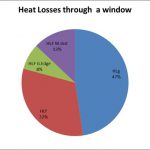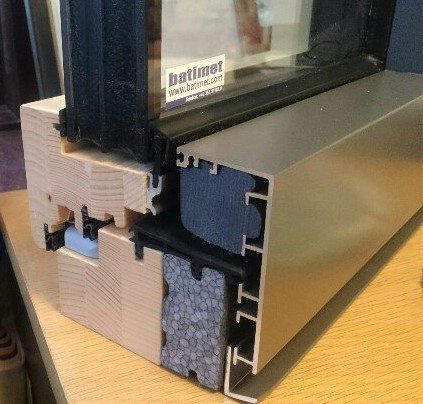There’s a ton of stuff written in relation to Passivhaus and the importance of window specification. In particular, we are told, getting your installation PSI-value down, and getting a good spacer-bar psi value, are vital. But just how important are they, compared to say, splashing out on top-notch PHI certified frames?
The following is a calculation that I’ve developed for taking window performance data in the Passivhaus format (i.e. separate Ug, Uf, psi values and frame dimensions) and calculating frame U-values for inputting into TAS, a dynamic simulation tool, which accounts for each frame separately, but does not provide an input for the psi-values separately.
The idea is to convert all the heat losses due to window frame heat transmission (area/U-value, and psi values for the installation and spacers) in to absolute heat losses in W/K, tot them all up for the whole building (or each different type of window in it), and divide by the area for frame to get an equivalent U-value that incorporates the linear psi values. You can now pop this straight into your TAS simulation file (there’s actually another step which I’ll come to). You can also do it separately for every window but that means you have to put in slightly different window U-values for every window – more effort than it’s worth in terms of the precision achieved, in my opinion.
Here’s an example using one window only.
My window data is as follows:
Glass U value (Ug) is 0.6 (i.e. pretty good triple glazing).
Sill, Jamb and Head widths are all 144mm.
Frame U-value (Uf) = 0.7
Spacer Bar PSI value = 0.03 (this is pretty good, something like a SwissSpacer)
Installation PSI value = 0.04 (standard PHPP assumption that can be improved upon with a bit of thought)
My window is 1500 x 1500mm, so Aw=2.25m2, Ag=1.47m2 and Af = 0.78m2.
Heat loss due to the frame only is therefore 0.59W/K
Length of the glazing edge is 4848mm and length of the structural opening edge is 6000mm, so the absolute heat losses from these elements are 0.15 W/K and 0.24 W/K respectively.
It’s worth setting this in the context of the whole window and the glass has an absolute heat loss of 0.88 W/K.
Here it is graphically:

So – although the glass and the frame dominate the heat losses, the glazing bar and installation do make a significant contribution when we’re looking at systems approaching PH standard. It’s certainly worth thinking about because the PSI values I’ve mentioned above won’t be achieved if you don’t get the spec and design nailed.
Another way to look at this is considering the frame alone, as is required by the TAS input. If I have to add 0.15 and 0.24 of linear heat losses to my frame heat loss I’m going from 0.59 to 0.98 – I’m almost doubling the heat loss from my frame, and that’s with reasonably good spacers and installation.
One final thing – on a couple of buildings I’ve worked on we’ve spec-ed frames that have a good but not great frame U-values but on the face of it, perform really well because they are very skinny (the absolute heat loss being a function of area and U-value. This can work well for Passivhauses because you also get more solar gain for a given structural opening, and it looks great on a contemporary building. However, the heat loss through the frame is less because the reduced area more than offsets increased U-value, and your PSI values, as a proportion of the frame heat loss, have a greater impact.
Building cost-effectively to good energy standards is about prioritising your budget on the areas which give you the most energy saving bang for buck (with certain caveats about compromising other aspects of performance), and getting these details right can do just that.
If you’d like to read more, the following presentation gives an excellent overview of installation psi-values, courtesy of Bronwyn Barry: Sills & Thresholds: Passive House Installation Details that boost performance. from Bronwyn Barry





